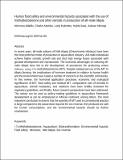| dc.description.abstract | In recent years, all-male cultures of Nile tilapia (Oreochromis niloticus) have been the most preferred mode of production in aquaculture industry. All-male individuals achieve higher somatic growth rate and shut high energy losses associated with gonadal development and reproduction. The economic advantages of culturing all-male tilapia have led to the development of procedures for producing unisex cultures, using 17α-methyltestosterone (MT). Despite widespread use of the MT in tilapia farming, the implications of hormone treatment in relation to human health and the environment have raised a number of concerns in the scientific community. In this review, the hormonal application processes, economic and ecological significance of MT, food safety and residual MT, comparative uses of steroids in aquaculture, animal husbandry, and medicine have been briefly reviewed for regulatory guidelines, and finally, future research perspectives have been addressed. The review can be used as policy-making guidelines in aquaculture framework development as can be emphasized in African continent, among others. The most important conclusion to draw is that the quantity of MT used in conventional practice is large compared to the actual dose required for sex reversal, fish produced are safe for human consumptions, and the environmental hazards should be further emphasized. | en_US |

